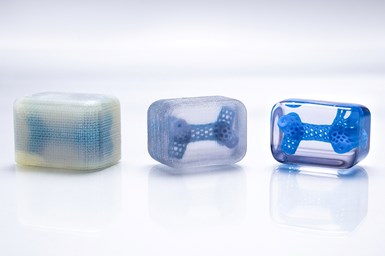AM Solutions’ C1 System for Automated Support Structure Removal
The system is said to feature innovative postprocessing of 3D printed components made from photopolymer resin, providing consistent and efficient removal of support structures utilizing an automated process.
Share
Read Next
With a combination of chemical, thermal and mechanical effects, a compound especially adapted to the respective photopolymer is said to ensure the consistent and complete removal of support structures. Photo Credit: AM Solutions
AM Solutions, a division of the Rösler group, has developed its C1 system with a postprocessing tool for the automated removal of support structures. The company says it meets the strictest industrial standards as well as fulfilling all requirements for process stability, consistent results, efficiency and traceability.
It is said photopolymer resins permit the high-quality printing of a large variety of precision functional components, design objects with extremely fine structures and the most complex prototypes. The C1 system is designed to enhance those resins by eliminating the manual removal of support structures, which may risk damaging components.
The compact plug-and-play machine was specially developed for the automated postprocessing of 3D printed photopolymer components and only needs a 230-V electrical outlet. The machine controls contain various processing programs which are said to enable the support removal from components with different shapes. In addition, users can tailor processing programs to their specific needs. The C1 system can handle 3D printed components with sizes of up to 340 × 440 × 170 mm.
For the postprocessing operation, the components are placed in a basket that, in turn, is dipped into an immersion bath filled with compound which is precisely adapted to the printing material. After the respective processing program has been called up, the process starts. This is based on chemical, thermal and mechanical effects. The effective interplay of these three mechanisms is said to ensure that the support structures can be reliably removed without affecting the dimensional integrity of the components. It is also said this is even the case with extremely delicate components with geometrically complex shapes and very thin walls. Compared to other systems available in the market, this process is significantly faster, the company says.
Monitoring the process parameters is said to ensure stable and cost-efficient operations. The system is equipped with various features designed to to guarantee process stability and minimize operational costs. This includes a sensor-controlled monitoring of the compound fill level. As soon as the level drops below a preset value, new compound is automatically replenished from a special container in the system. An integrated, removable skimming (overflow) screen enables the discharge of removed, gelatinous support material from the compound. This is said to significantly increase the usable life of the compound. Moreover, an integrated sensor monitoring the degree of contamination signals when a compound exchange is needed. It is said to ensure that such an exchange does not take place too early or too late, saving costs and guaranteeing a consistently high processing quality.
Related Content
-
How Does Heat Treating Affect Machining Considerations for a Metal 3D Printed Part?
This picture of part distortion in additive manufacturing illustrates the kind of effects that part design or machining stock allowances need to anticipate.
-
Copper, New Metal Printing Processes, Upgrades Based on Software and More from Formnext 2023: AM Radio #46
Formnext 2023 showed that additive manufacturing may be maturing, but it is certainly not stagnant. In this episode, we dive into observations around technology enhancements, new processes and materials, robots, sustainability and more trends from the show.
-
DMG MORI: Build Plate “Pucks” Cut Postprocessing Time by 80%
For spinal implants and other small 3D printed parts made through laser powder bed fusion, separate clampable units resting within the build plate provide for easy transfer to a CNC lathe.















